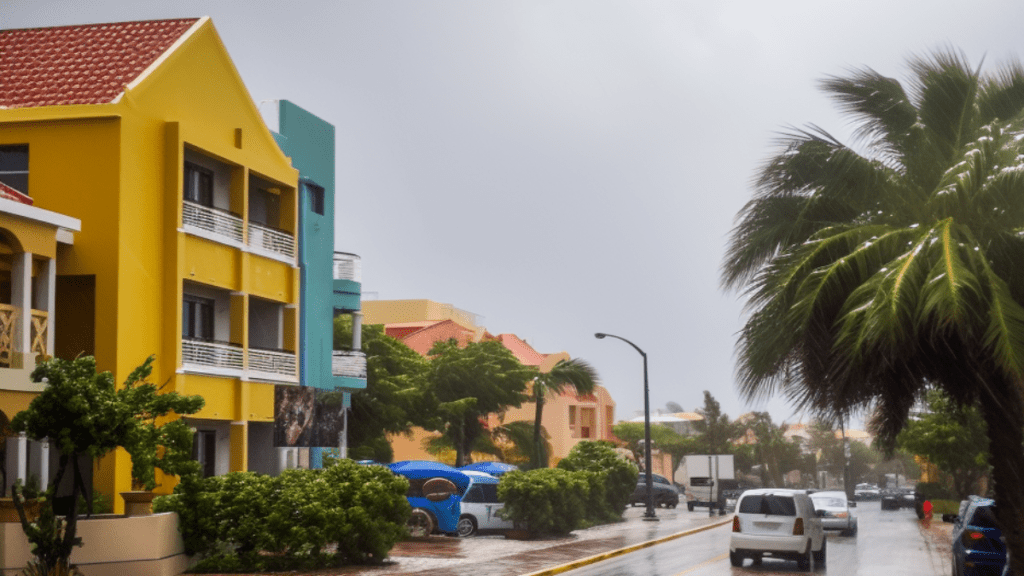Weather can ruin a trip, and if you are planning a February trip to Aruba, you’re probably wondering is Aruba rainy in February? February is actually the end of rainy season, so although it is a bit rainier than other months, the rain usually tapers off as the month progresses. Most days are warm and sunny. Here’s the most important things to consider regarding rain in Aruba in February:
- Aruba February Rain Statistics – Aruba averages 1.57 inches of rain in February. On average, 7 days in February receive rainfall. This makes February the sixth rainiest month in Aruba. There is a minor risk rain could disrupt part of your trip, but most days are warm and sunny.
- Aruba’s Climate – Aruba has a semi-arid climate, which is characterized by low precipitation and high temperatures throughout the year. Specifically, the island receives an average of only 15 inches (380 mm) of rainfall annually. The vast majority falls between the months of October and January, so the beginning of February may be impacted by that.
- Other Weather – Most days in February are warm and sunny. The average high temperature in Aruba in February is 86 degrees Fahrenheit (30c). The wind can be extreme at times with average wind speeds for February at 16 mph. UV can also be extreme. February is NOT part of the Atlantic hurricane season. To learn more, visit our article: Is February a Good Time to Visit Aruba?
The main takeaway is you can expect Aruba in February to be a little rainier than average since February is at the tail end of the island’s rainy season. But the chances of extreme rain are very low. Most days in Aruba in February are warm and sunny.
Here is a monthly breakdown of average rain in inches for Aruba:
| Month | Avg Rain (Inches) |
| January | 2.36 |
| February | 1.57 |
| March | 0.39 |
| April | 0.39 |
| May | 0.79 |
| June | 0.39 |
| July | 0.79 |
| August | 0.39 |
| September | 1.97 |
| October | 3.15 |
| November | 3.54 |
| December | 3.15 |
Table of Contents
How Rainy is Aruba in February?
February is at the tail end of the rainy season in Aruba, so rain tapers off throughout the month.
On average, Aruba has 7 days of rain in February (source). The average total rainfall for the month of February in Aruba is 1.57 inches.
February is the sixth rainiest month on average in Aruba. Therefore, there is only a minor risk that rain will disrupt part of your trip. Aruba has a dry climate, and even the rainy season doesn’t get as much rain as other Caribbean islands.

Out of roughly 700 islands in the Caribbean, Aruba consistently ranks as having the least amount of rainfall (Aruba averages approximately 15 inches for the entire year).
If you want to take precaution against unexpected rain, the eastern and southern part of the island usually receives less rainfall than the northern and western parts. The capital city of Oranjestad and the popular tourist areas of Palm Beach and Eagle Beach are located on the southern and eastern parts of the island and typically receive the least amount of rainfall.
The northern and western parts of the island, such as the Arikok National Park and the towns of San Nicolas and Savaneta, receive slightly more rainfall. However, as we discussed above, compared to other Caribbean islands, the overall rainfall in Aruba is low and does not greatly affect tourist activities.
If you want to visit Aruba and not worry about rain at all, the dry season runs from March through August (but, again, Aruba is relatively dry year round).
Aruba Average Days of Rain by Month
| Month | Avg Days of Rain |
| January | 12 |
| February | 7 |
| March | 4 |
| April | 3 |
| May | 3 |
| June | 4 |
| July | 7 |
| August | 4 |
| September | 5 |
| October | 8 |
| November | 11 |
| December | 13 |
SOURCE: Holiday-Weather
Aruba Average Rainfall by Month
| Month | Avg Rain (Inches) |
| January | 2.36 |
| February | 1.57 |
| March | 0.39 |
| April | 0.39 |
| May | 0.79 |
| June | 0.39 |
| July | 0.79 |
| August | 0.39 |
| September | 1.97 |
| October | 3.15 |
| November | 3.54 |
| December | 3.15 |
SOURCE: Holiday-Weather
What Parts of Aruba Get the Most Rain?
The northern and eastern parts of Aruba tend to get more rain than the western and southern parts. This is because of the island’s topography, which includes hills and mountains that affect the distribution of rainfall.
When the prevailing winds blow from the northeast, they are forced to rise over the hills and mountains on the northern and eastern parts of the island. As the air rises, it cools and condenses, leading to the formation of clouds and rainfall.

In contrast, the western and southern parts of the island are sheltered by the hills and mountains, which create a rain shadow effect. The prevailing winds that come from the northeast lose their moisture as they pass over the mountains and descend on the other side, leading to drier conditions in the west and south.
It’s also worth noting that Aruba’s rainfall is highly variable, and the amount of rain that falls can vary greatly from year to year. This is because Aruba is located outside of the hurricane belt, and most of its rainfall comes from passing weather systems, such as tropical waves and disturbances.
These weather systems can be unpredictable and difficult to forecast, which can make it challenging to determine exactly which parts of the island will receive the most rain at any given time.
Aruba’s February Weather
Although February in Aruba does receive some rain, most days are warm and sunny. The average high temperature in Aruba in February is 86 degrees Fahrenheit (30c).
The wind can be extreme at times in February with average wind speeds of 16 mph. Many people like the wind because it brings relief on muggy days and often creates a pleasant breeze at night. UV strength can also be extreme this time of year.
February is NOT part of the Atlantic hurricane season, which runs from June 1st to November 30th.
Something to consider about February in Aruba is daylight hours. February provides 11.7 daylight hours on average, which ranks it near the bottom out of all months in Aruba. This means days will be a bit shorter than most other months. If you want longer days, the summer months will be the better option.
